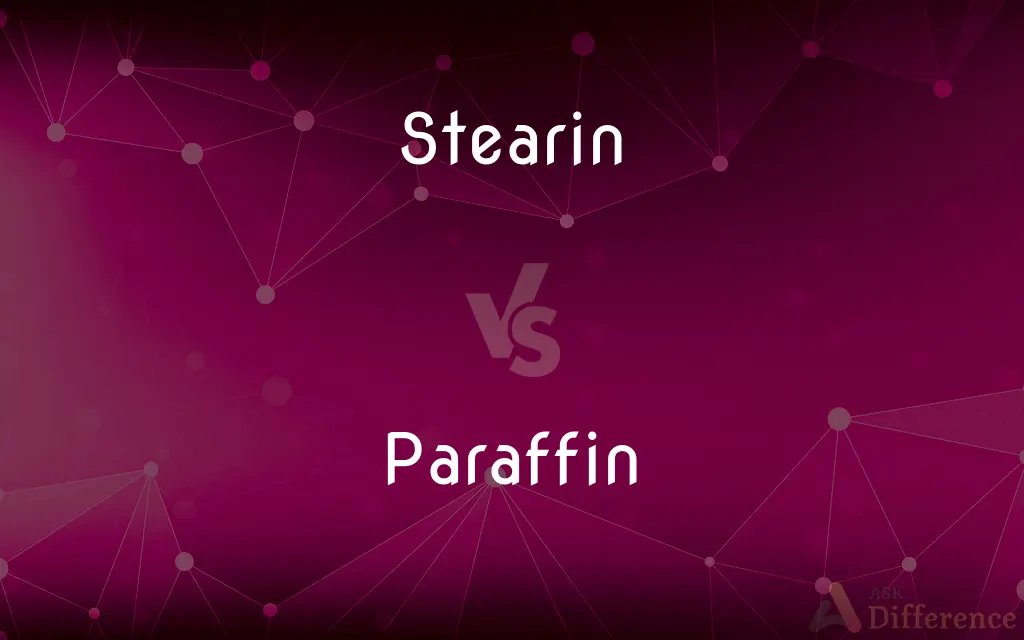Stearin vs. Paraffin — What's the Difference?
By Urooj Arif & Fiza Rafique — Updated on March 27, 2024
Stearin is a solid fatty substance derived from animal or vegetable fats, used in candle making, whereas paraffin is a hydrocarbon-based wax used widely for its low melting point and inert properties.

Difference Between Stearin and Paraffin
Table of Contents
ADVERTISEMENT
Key Differences
Stearin, derived from natural fats, is known for its role in producing hard, long-burning candles, contributing to a stable and consistent flame. It is often preferred for its eco-friendly and renewable qualities, appealing to those seeking natural alternatives. Paraffin, on the other hand, is a byproduct of the petroleum industry, valued for its versatility and ease of use in candle making. Its clear, odorless nature allows for the addition of dyes and fragrances, making paraffin candles popular for their vibrant colors and scents.
Stearin candles are celebrated for their minimal dripping and smoke, making them a choice for dining and decorative purposes. However, stearin's source and processing can affect its cost, making it potentially more expensive than synthetic options. Paraffin's lower cost and wide availability have made it a staple in the candle industry, offering consumers a range of affordable products. Yet, concerns over its non-renewable origin and potential health impacts when burned have led some to seek alternatives.
In terms of environmental impact, stearin stands out as a more sustainable choice, aligning with the growing demand for eco-friendly products. The use of natural sources for stearin supports sustainable agriculture and reduces reliance on fossil fuels. Conversely, the production of paraffin wax contributes to the petroleum industry's environmental footprint, raising questions about sustainability and carbon emissions.
The burning characteristics of these waxes also differ. Stearin candles tend to have a higher melting point, resulting in a slower burn rate and longer candle life. This contrasts with paraffin candles, which melt at a lower temperature, potentially leading to a quicker burn and shorter lifespan. The choice between stearin and paraffin often comes down to preferences regarding burn time, environmental considerations, and cost.
Regarding health and safety, stearin is perceived as a healthier option, with fewer concerns about toxic byproducts during burning. This perception aligns with the shift towards natural and non-toxic home products. Meanwhile, some studies have raised concerns about the emissions from paraffin candles and their impact on indoor air quality, driving some consumers towards natural wax alternatives.
ADVERTISEMENT
Comparison Chart
Source
Derived from animal or vegetable fats
Petroleum byproduct
Environmental Impact
Renewable and eco-friendly
Non-renewable, with potential environmental concerns
Cost
Generally more expensive due to natural sourcing
Less expensive, widely available
Burning Characteristics
Higher melting point, slower burn rate, longer life
Lower melting point, quicker burn, potentially shorter life
Health and Safety
Perceived as healthier, fewer toxic byproducts
Concerns over emissions and indoor air quality
Compare with Definitions
Stearin
Known for its superior burning qualities, including minimal dripping.
The stearin candle burned evenly, with hardly any wax dripping down its sides.
Paraffin
Has a lower melting point, which can affect burn time and wax drip.
The paraffin candle melted quickly, pooling wax around its base.
Stearin
Offers a stable and consistent flame, ideal for ambiance lighting.
The steady glow of the stearin candle created a cozy atmosphere in the living room.
Paraffin
More affordable and accessible than many natural wax alternatives.
For budget-friendly decor, paraffin candles are an excellent choice.
Stearin
A hard, solid substance obtained from animal or vegetable fats, used in making candles.
Stearin candles adorned the dining room, offering a warm, flickering light.
Paraffin
Raises concerns regarding sustainability and air quality when burned.
Some avoid paraffin candles due to worries about their environmental impact and health effects.
Stearin
Can be more expensive due to its natural origins.
Despite the higher cost, many prefer stearin candles for their natural and clean-burning properties.
Paraffin
Easily colored and scented, allowing for a variety of candle designs.
The brightly colored paraffin candles emitted a sweet fragrance that filled the air.
Stearin
Stearin is renewable and considered more eco-friendly than synthetic waxes.
Choosing stearin candles supports sustainable practices and reduces environmental impact.
Paraffin
A colorless, odorless wax made from petroleum, used extensively in candle making.
The paraffin candles filled the room with a soft, inviting glow.
Stearin
Stearin , or tristearin, or glyceryl tristearate is an odourless, white powder. It is a triglyceride derived from three units of stearic acid.
Paraffin
A waxy white or colorless solid hydrocarbon mixture used to make candles, wax paper, lubricants, and sealing materials. Also called paraffin wax.
Stearin
See tristearin.
Paraffin
(Chemistry) A member of the alkane series.
Stearin
The solid form of fat.
Paraffin
Chiefly British Kerosene.
Stearin
Solid fat.
Paraffin
To saturate, impregnate, or coat with paraffin.
Stearin
(organic compound) A glyceride (especially the triglyceride) of stearic acid
Paraffin
(UK) A petroleum-based thin and colourless fuel oil.
Stearin
One of the constituents of animal fats and also of some vegetable fats, as the butter of cacao. It is especially characterized by its solidity, so that when present in considerable quantity it materially increases the hardness, or raises the melting point, of the fat, as in mutton tallow. Chemically, it is a compound of glyceryl with three molecules of stearic acid, and hence is technically called tristearin, or glyceryl tristearate.
Paraffin
(chemistry) Any member of the alkane hydrocarbons.
Stearin
An ester of glycerol and stearic acid
Paraffin
Paraffin wax.
Paraffin
To impregnate or treat with paraffin.
Paraffin
To embed in paraffin wax.
Paraffin
A white waxy substance, resembling spermaceti, tasteless and odorless, and obtained from coal tar, wood tar, petroleum, etc., by distillation. It is used in candles, as a sealing agent (such as in canning of preserves), as a waterproofing agent, as an illuminant and as a lubricant. It is very inert, not being acted upon by most of the strong chemical reagents. It was formerly regarded as a definite compound, but is now known to be a complex mixture of several higher hydrocarbons of the methane or marsh-gas series; hence, by extension, any substance, whether solid, liquid, or gaseous, of the same chemical series; thus gasoline, coal gas and kerosene consist largely of paraffins.
Paraffin
From crude petroleum; used for candles and for preservative or waterproof coatings
Paraffin
A non-aromatic saturated hydrocarbon with the general formula CnH(2n+2)
Paraffin
British usage
Common Curiosities
Are stearin candles more expensive than paraffin candles?
Generally, yes, due to the cost of sourcing natural ingredients.
Is paraffin wax biodegradable?
No, paraffin wax is not biodegradable, as it is a petroleum byproduct.
Why do some people prefer stearin over paraffin candles?
People prefer stearin for its natural, renewable qualities and minimal environmental impact.
Can paraffin candles be scented and colored?
Yes, paraffin's clear, odorless nature allows easy addition of dyes and fragrances.
What is stearin made from?
Stearin is made from the solid fraction of animal or vegetable fats.
Are paraffin candles bad for your health?
Some studies suggest that burning paraffin candles may release harmful toxins, raising health concerns.
Does the type of wax affect candle scent throw?
Yes, the wax type can influence how well a candle releases fragrance.
Do stearin candles burn longer than paraffin candles?
Yes, due to their higher melting point, stearin candles often have a longer burn time.
Are there any alternatives to stearin and paraffin for candle making?
Alternatives include soy wax, beeswax, and palm wax, each with unique properties.
Can I find candles that mix stearin and paraffin?
Yes, blends are common to balance cost, burning properties, and sustainability.
Why is stearin considered eco-friendly?
Stearin is renewable and sourced from sustainable agriculture, reducing environmental impact.
What are the main uses of stearin besides candles?
Stearin is also used in making soaps, cosmetics, and as a hardener in other products.
Can stearin candles be used outdoors?
Yes, their slow-burning nature makes them suitable for outdoor use.
How do I choose between stearin and paraffin candles?
Consider factors like environmental impact, burn time, cost, and personal health concerns.
Is it easy to work with paraffin wax in candle making?
Yes, paraffin's low melting point and versatility make it popular among candle makers.
Share Your Discovery

Previous Comparison
Organogram vs. Organigram
Next Comparison
Primarily vs. MainlyAuthor Spotlight
Written by
Urooj ArifUrooj is a skilled content writer at Ask Difference, known for her exceptional ability to simplify complex topics into engaging and informative content. With a passion for research and a flair for clear, concise writing, she consistently delivers articles that resonate with our diverse audience.
Co-written by
Fiza RafiqueFiza Rafique is a skilled content writer at AskDifference.com, where she meticulously refines and enhances written pieces. Drawing from her vast editorial expertise, Fiza ensures clarity, accuracy, and precision in every article. Passionate about language, she continually seeks to elevate the quality of content for readers worldwide.














































